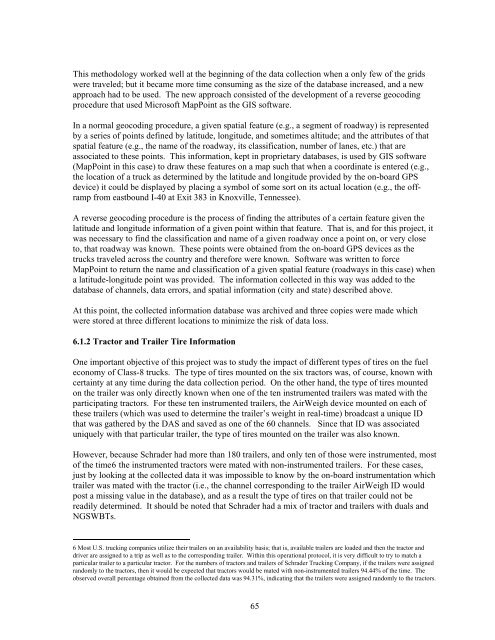Class-8 Heavy Truck Duty Cycle Project Final Report - Center for ...
Class-8 Heavy Truck Duty Cycle Project Final Report - Center for ...
Class-8 Heavy Truck Duty Cycle Project Final Report - Center for ...
Create successful ePaper yourself
Turn your PDF publications into a flip-book with our unique Google optimized e-Paper software.
This methodology worked well at the beginning of the data collection when a only few of the grids<br />
were traveled; but it became more time consuming as the size of the database increased, and a new<br />
approach had to be used. The new approach consisted of the development of a reverse geocoding<br />
procedure that used Microsoft MapPoint as the GIS software.<br />
In a normal geocoding procedure, a given spatial feature (e.g., a segment of roadway) is represented<br />
by a series of points defined by latitude, longitude, and sometimes altitude; and the attributes of that<br />
spatial feature (e.g., the name of the roadway, its classification, number of lanes, etc.) that are<br />
associated to these points. This in<strong>for</strong>mation, kept in proprietary databases, is used by GIS software<br />
(MapPoint in this case) to draw these features on a map such that when a coordinate is entered (e.g.,<br />
the location of a truck as determined by the latitude and longitude provided by the on-board GPS<br />
device) it could be displayed by placing a symbol of some sort on its actual location (e.g., the offramp<br />
from eastbound I-40 at Exit 383 in Knoxville, Tennessee).<br />
A reverse geocoding procedure is the process of finding the attributes of a certain feature given the<br />
latitude and longitude in<strong>for</strong>mation of a given point within that feature. That is, and <strong>for</strong> this project, it<br />
was necessary to find the classification and name of a given roadway once a point on, or very close<br />
to, that roadway was known. These points were obtained from the on-board GPS devices as the<br />
trucks traveled across the country and there<strong>for</strong>e were known. Software was written to <strong>for</strong>ce<br />
MapPoint to return the name and classification of a given spatial feature (roadways in this case) when<br />
a latitude-longitude point was provided. The in<strong>for</strong>mation collected in this way was added to the<br />
database of channels, data errors, and spatial in<strong>for</strong>mation (city and state) described above.<br />
At this point, the collected in<strong>for</strong>mation database was archived and three copies were made which<br />
were stored at three different locations to minimize the risk of data loss.<br />
6.1.2 Tractor and Trailer Tire In<strong>for</strong>mation<br />
One important objective of this project was to study the impact of different types of tires on the fuel<br />
economy of <strong>Class</strong>-8 trucks. The type of tires mounted on the six tractors was, of course, known with<br />
certainty at any time during the data collection period. On the other hand, the type of tires mounted<br />
on the trailer was only directly known when one of the ten instrumented trailers was mated with the<br />
participating tractors. For these ten instrumented trailers, the AirWeigh device mounted on each of<br />
these trailers (which was used to determine the trailer’s weight in real-time) broadcast a unique ID<br />
that was gathered by the DAS and saved as one of the 60 channels. Since that ID was associated<br />
uniquely with that particular trailer, the type of tires mounted on the trailer was also known.<br />
However, because Schrader had more than 180 trailers, and only ten of those were instrumented, most<br />
of the time6 the instrumented tractors were mated with non-instrumented trailers. For these cases,<br />
just by looking at the collected data it was impossible to know by the on-board instrumentation which<br />
trailer was mated with the tractor (i.e., the channel corresponding to the trailer AirWeigh ID would<br />
post a missing value in the database), and as a result the type of tires on that trailer could not be<br />
readily determined. It should be noted that Schrader had a mix of tractor and trailers with duals and<br />
NGSWBTs.<br />
6 Most U.S. trucking companies utilize their trailers on an availability basis; that is, available trailers are loaded and then the tractor and<br />
driver are assigned to a trip as well as to the corresponding trailer. Within this operational protocol, it is very difficult to try to match a<br />
particular trailer to a particular tractor. For the numbers of tractors and trailers of Schrader <strong>Truck</strong>ing Company, if the trailers were assigned<br />
randomly to the tractors, then it would be expected that tractors would be mated with non-instrumented trailers 94.44% of the time. The<br />
observed overall percentage obtained from the collected data was 94.31%, indicating that the trailers were assigned randomly to the tractors.<br />
65
















